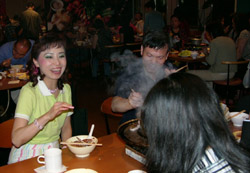隨後由林得恩先生上台進行與實踐共生化有關之氣象方面調查方法論的演說「The Micro-climate Meteorological Station Data Feedback the Real Life Application and Adjustment for the Building」、羅陽青先生進行有關微生物方面之演說「How to Identify the Microorganisms?」、蔡坤憲先生進行有關節肢動物方面之演說「Bio-climatic Design of SB in Tropical & Subtropical Region Surveillance of Symbiotic Arthropods」及鍾政勳先生進行有關野菜方面之演說「Wild Edible Plants」。最後,則由黃晉英秘書長總結:「這四個重要工具當然不足以直接導出共生化(Symbiosis),其他相關的知識也必要累積,面對如此複雜的自然環境,我們需要更多的知識或專家來協助。因此,在此次的Student Session只能做個開頭,透過國際的分工與合作,在未來我們希望台灣可以做為協助者的角色,幫助各位繼續累積知識,完成屬於你們自己的永續建築(SB)。相信未來在各種研討會上,我們還有機會相互學習,也期盼這次簡短的Student Session可以給各位一個好的思考起點。在面對能源匱乏,全球氣候異變的情勢下,我們應做出革命性的行動,以綠建築(GB)加上共生化(Symbiosis)的行動達到永續建築(SB)的目標,鼓勵大家共同為人類的永續發展貢獻一份力量,我們期盼下一次的見面!」為時75分鐘的演說內容就此告一段落。在短暫中場休息後,開始進行熱烈的問答與研討。因為與會的學員大部分都是建築背景出身,所以提出的疑問大致上都環繞在祐生研究基金會的研究內容以及共生圈一號實驗的目的與方式上,而考察團的研究團隊們也開誠布公地予以解說,希望讓參與的學員們充分掌握第一手的資料,不虛此行。受限於時間的關係,研討必須劃下句點。
Then, Mr. Lin De-en went on the stage to present his report on " The Micro-climate Meteorological Station Data Feedback the Real Life Application and Adjustment for the Building", Mr. Luo Yang-ching the report on " How to Identify the Microorganisms?", Mr. Tsai Kun-hsien the report on " Bio-climatic Design of SB in Tropical & Subtropical Region Surveillance of Symbiotic Arthropods ",and Mr. Chung Cheng-hsin the report on " Wild Edible Plants ". Secretary General Huang Chin-ying drew the final conclusion after these reports,"Though these four tools are important, symbiosis can never be accomplished by these four tools alone. In fact, we need to accumulate relevant knowledge because we need much more knowledge and specializations to face the complex natural environment. Therefore, what we have just presented at this Student Session is just the beginning. Through international division of labor, we hope that Taiwan can be the coordinator to help you continually accumulate knowledge for accomplishing the SB of your own. We believe that there are great many chances for us to learn from one another in future conferences of different kinds. We wish that our toils at this brief Student Session can bring you a good start of thinking. In a time of energy shortage and global climate change, revolutionary actions should be taken to in order to accomplish SB by combining GB and symbiosis. We hereby urge every one of you to try you best for the sustainable development of mankind, and we are looking forward to seeing you next time!" The 75-minute speech ended at this moment, and the heated Q&A and discussions followed after a short intermission. As most participants have architecture background, most questions were about the content of the researches conducted by the Archilife Research Foundation and the objectives and approaches of the experiments at Symbiosphere 1 Center. Members of the research teams participating in the delegation did their best to answer all those questions, hoping to share the first-hand information with students at the meeting. The seminar was ended unwillingly because of time.

所有人員隨即分搭二部巴士,在江哲銘評審委員與張桂鳳小姐的導覽下,前往參觀東京代官山地區,見證東京建築及都市發展的演進歷程。目前,這個區塊正在急速進入第 2 次開發的建設期。代官山曾是日本集體住宅的創始地,這些曾做為歷史象徵物的簡易公寓已被拆除,取而代之的是高層的綜合型購物中心。在考察團參訪的途中,到處充滿著散步與城市花園的氣氛,是出售各種日用小商品的市場,在代官山最容易找到獨具風格的服裝以及飾品,也就是各大百貨公司都沒有的風格,這裏銷售的貨品品質優良,尤其受到年輕女性的歡迎。參觀完後,考察團一行驅車前往新宿體驗一般日式吃到飽的用餐方式,讓考察團員更貼近日本民眾的生活脈動,從另一面觀察日本的風土民情。
Under the guidance of Mr. Chiang Che-ming and Miss Chang Kuei-feng, everybody went to Daikanyama on two buses to explore the history of architectural and urban development of Tokyo. The block was in its rapid second development. Daikanyama was the origin of collective housing in Japan. Those simple apartments that witnessed history have long been demolished and became multistory integrated shopping malls. During the trip, we felt the atmosphere of leisure and city garden and saw markets selling daily articles everywhere. Here in Daikanyama, we could find clothes and accessories of unique styles; i.e. styles that couldn't be found in department stores. Merchandises here were of high quality and favored by young ladies in particular. After the trip to Daikanyama, the delegation headed for Shinjuku to experience the one price for all general Japanese food, so that delegates could understand more about the true everyday lives of Japanese people, another kind of investigation of Japanese culture.